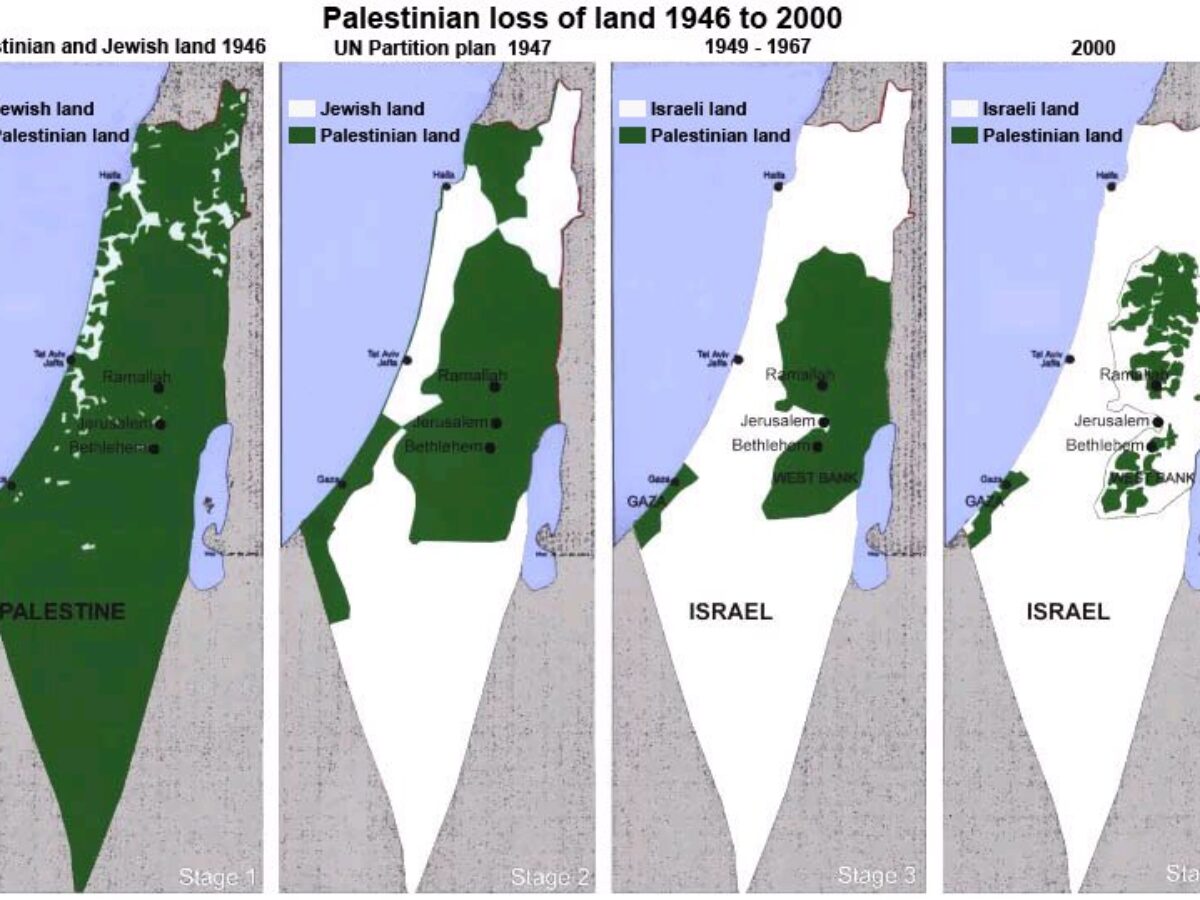The Zionist movement sparked a flood of Jewish immigration to Palestine in the late 19th century. Because of the theological and historical ties to Palestine, Zionism aimed to build a Jewish homeland there. Arab nationalists who were staking claims to the region’s territory and advancing their own national goals opposed this movement. Arab and Jewish leaders in the area received contradictory assurances from the British and French during World War I. The Balfour Declaration, published by the British government in 1917, expressed support for the creation of a “national home for the Jewish people” in Palestine. Although the Zionist movement applauded this announcement, tensions between the Arab and Jewish communities arose. In 1920, following the fall of the Ottoman Empire, Britain was granted a mandate by the League of Nations to oversee Palestine. The British had difficulties carrying out their contradictory promises to Arabs and Zionists. As Jewish immigration persisted, tensions with the Arab populace grew. Palestinian Arabs spearheaded the 1936–1939 Arab Revolt in Palestine, which sought to oppose Jewish immigration and British control. Although the British put an end to the uprising, it was a turning point in the history of Palestinian Arab nationalism and the rejection of Zionist ambitions. Support for a Jewish homeland increased internationally after World War II and the Holocaust. The UN Partition Plan of Palestine was a 1947 proposal that attempted to resolve the issue in Palestine between the Arab and Jewish communities. It suggested dividing Palestine into distinct Arab and Jewish states, with Jerusalem falling under international supervision. Fifty-six percent of the area was allotted to the Jewish state and 43% to the Arab state under the proposal. While Arab countries and Palestinian authorities opposed the plan, Jewish leaders approved it. The strategy prepared the groundwork for the 1948 Arab Israeli War, which led to the creation of the State of Israel. The partition plan is still a divisive topic that influences conversations about the Israeli-Palestinian conflict.
Nakba and Palestinian Refugees:
The 1948 Arab Israeli War, also known as the War of Independence for Israelis and the Nakba (“catastrophe”) for Palestinians, resulted in the displacement of hundreds of thousands of Palestinians. Many fled or were expelled from their homes, becoming refugees in neighboring Arab countries or within the West Bank and Gaza Strip.
 First Arab-Israel war 1948-1949:
First Arab-Israel war 1948-1949:
1948 saw the newly formed State of Israel engage in combat with several Arab states in the First Arab Israeli War. When Israel declared its independence and rejected the UN plan for Palestine’s partition, Arab countries—including Egypt, Jordan, Syria, and Iraq—began military campaigns against the state. There was fierce combat throughout the conflict on several fronts, which led to a large-scale Palestinian Arab displacement. Israel was outnumbered and had few resources, but it was still able to muster its men, win battles, and protect and even increase its territory.
Egypt nationalized the Suez Canal in 1956, sparking the start of the Suez Crisis, a significant global crisis. Israel, Britain, and France responded by launching a military invasion to reclaim.
Six days (Second Arab-Israel) war 1967:
The 1967 conflict between Israel and the Arab states of Egypt, Jordan, and Syria took place during the Second Arab Israeli War, commonly referred to as the Six-Day War. The military build-up in the area and rising tensions were the main causes of the war. Israel destroyed the Egyptian air force in a series of well-coordinated airstrikes against Egyptian air bases as a preemptive strike. After that, Israel increased the scope of its attack by taking the Golan Heights from Syria, the West Bank from Jordan, and the Sinai Peninsula from Egypt. Six days, from June 5 to June 10, 1967, saw the start of the conflict. The conflict ended with Israel decisively victorious. The Israeli military exhibited exceptional military prowess and synchronization, culminating in the conquest of noteworthy regions. Israel gained sovereignty over the Golan Heights, the West Bank, East Jerusalem, the Sinai Peninsula, and the Gaza Strip during the war, which altered the geopolitical face of the area. Tensions between Israel and the Arab states that it borders grew as a result, and Palestinian Arabs were forced to relocate. The Israeli-Palestinian conflict became even more complex because of the war’s contribution to the Israeli settlement activity in the occupied areas. There were attempts to use diplomacy to end the conflict, which resulted in UN resolutions and peace talks. But the unsolved problems and conflicting national ambitions still feed tensions and arguments in the region.
Arab-Israel War 1973:
Known by several names, including the Yom Kippur War and the Ramadan War, the Arab Israeli War of 1973 pitted Israel against a coalition of Arab nations headed by Egypt and Syria. On October 6, 1973, the war broke out amid the Muslim holy month of Ramadan and the Jewish holiday of Yom Kippur. To recover territory that Israel had lost to Syria and Egypt during the 1967 Six-Day War, the two countries unexpectedly attacked Israeli forces in the Golan Heights and the Sinai Peninsula. At first, the Arab forces advanced significantly, surprising the Israeli Defense Forces. But Israel rapidly raised its armed forces and began a counteroffensive. With American assistance, Israel was able to change the course of the conflict. Threatening the capitals of the Arab world, Israeli forces advanced well into Egyptian and Syrian territory. The war resulted in heavy casualties on both sides and led to significant political and diplomatic consequences. International pressure, including from the United States and the Soviet Union, led to a ceasefire agreement, but not before Israel had made substantial territorial gains. The conflict highlighted the vulnerabilities of the Israeli military and intelligence, and it marked a turning point in the Israeli-Arab conflict. The war also led to a reassessment of peace efforts, eventually leading to the Camp David Accords between Israel and Egypt in 1978. The Camp David Accords marked the first official recognition and peace treaty between Israel and an Arab nation.
First Intifada 1987:
A six-year Palestinian rebellion against Israeli occupation, known as the First Intifada, started in 1987. Palestinian resentment of Israeli practices such land seizure and travel restrictions served as its main motivator. The rebellion brought attention from around the world and brought about important political changes by using civil disobedience, protests, and resistance against Israeli forces. It was essential in defining the Israeli-Palestinian conflict and helped bring about the 1993 signing of the Oslo Accords. Israel and the Palestine Liberation Organization came to an agreement known as the Oslo Accords, which set the stage for future peace talks and the eventual establishment of Palestinian self-rule. By resolving numerous difficulties and splitting the West Bank into distinct zones of control, the Oslo II Accord of 1995 advanced the peace process.

Second Intifada 2000:
The Second Intifada, also known as the Al-Aqsa Intifada, was a period of intense conflict between Israelis and Palestinians that began in 2000. It was characterized by widespread protests, demonstrations, and acts of violence. The conflict escalated with armed attacks, suicide bombings, and military operations. The Second Intifada resulted in significant casualties and further complicated efforts to reach a peaceful resolution. It deepened divisions and had a lasting impact on Israeli-Palestinian relations.
In the 2006 Palestinian legislative elections, the Hamas movement won a majority of seats in the Palestinian Legislative Council, defeating the long-dominant Fatah party.

RESEARCH ASSOCIATE



